What is Tetra Fish?
Tetra fish are a type of freshwater fish that are popular among aquarium enthusiasts. They are known for their bright colors and interesting patterns.
There are over 100 different species of Tetras, each with its unique coloration and patterning. The most common Tetra species kept as pets are the neon Tetra (Paracheirodon innesi), black widow Tetra (Gymnocorymbus ternetzi), and Congolese Tetra (Phenacogrammus interruptus).
Most Tetra Fish are native to South America, but there are a few species that come from Africa and Asia. Tetra fish generally prefer warm waters and will not do well in cooler climates.
They are also known to be very social creatures and do best when they are kept in groups. In the wild, Tetras can be found in rivers, streams, and lakes. They prefer water that is clear and slightly acidic.
Tetras are a popular choice for beginner aquarium enthusiasts because they are relatively easy to care for and do not require a lot of space.
They are also very peaceful fish and can be kept with other tank mates that are similarly sized. However, it is important to note that some species of Tetras can be aggressive towards each other, so it is important to do your research before purchasing any fish.
Types of Tetra Fish
Some of the most popular Tetra Fish include:
Neon Tetras
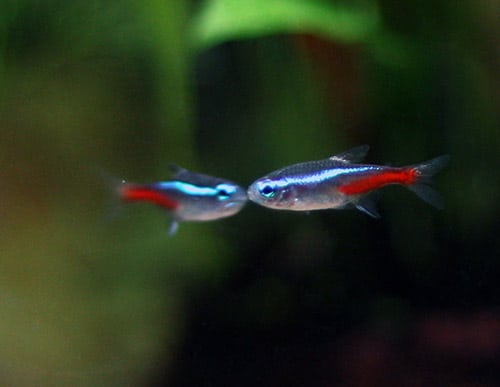
One of the most brightly colored Tetra species, neon Tetras are native to the waterways of South America. These fish are known for their striking blue and red stripes which run along with their bodies from head to tail.
Neon Tetras grow to be about 2 inches long and prefer to live in groups of 6 or more.
Cardinal Tetras
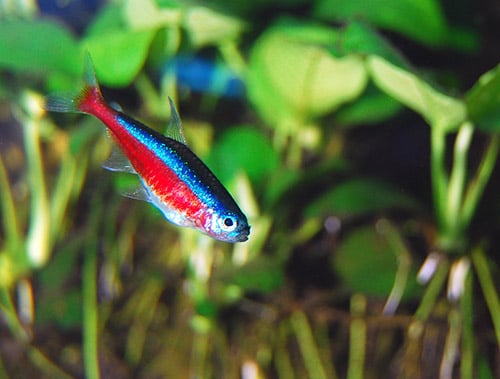
Cardinal Tetras are another popular type of Tetra that is native to the South American countries of Brazil and Guyana. These fish get their name from their bright red coloration, which is similar to that of a cardinal bird.
A fully-grown Cardinal Tetras can reach 2.5 inches long. You can put them to live in a group of 8 or more, as they are peaceful and low-maintenance tank fish.
Black Neon Tetras
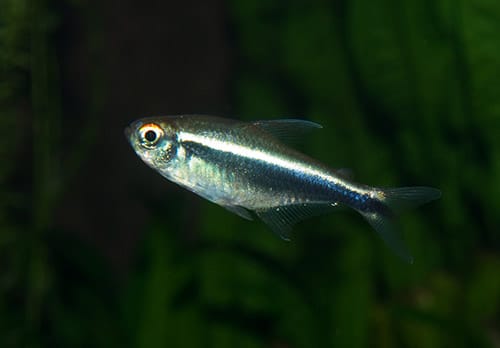
As their name suggests, black neon Tetras are a variety of neon Tetra that has a dark black stripe running along its body instead of the typical blue and red stripes. These fish are native to the same region as regular neon Tetras (South America).
Their common size is about 2 inches. And, Black neon Tetras also prefer to live in groups of 6 or more.
Dwarf Neon Tetras
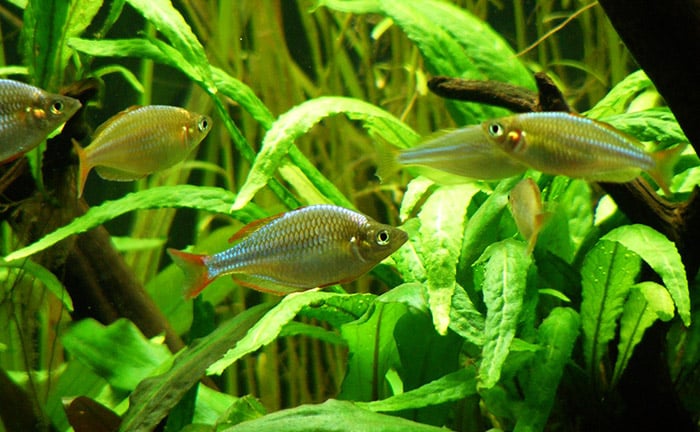
Dwarf neon Tetras are a smaller variety of neon Tetra that only grows to be about 1.5 inches long. These fish are native to the same region as regular neon Tetras (South America) and prefer to live in groups of 8 or more.
Serpae Tetras
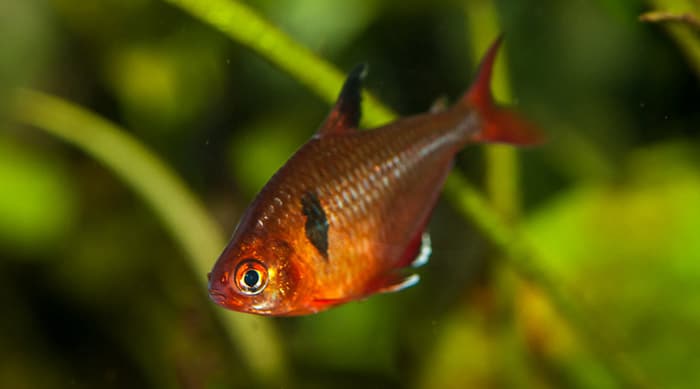
Serpae Tetras are a type of Tetra that is native to the South American countries of Brazil, Peru, and Bolivia. These fish are known for their bright red coloration and long, flowing fins.
This flamed-color Tetras is pretty popular among aquarists. And their size is ideal for home tanks too, as Serpae Tetras’s full length is about 2.5 inches.
Penguin Tetras
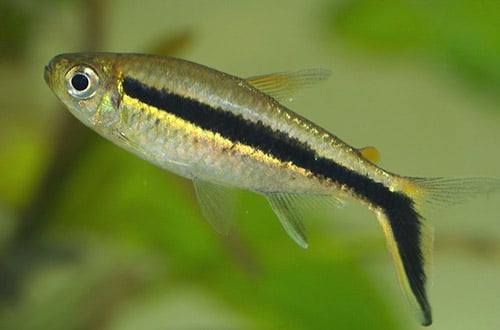
Penguin Tetras are a type of Tetra that is native to the South American country of Brazil. These fish get their name from their black and white coloration, which is similar to that of a penguin bird.
Penguin Tetras can reach a length of about 2 inches. For your information, Pencil fish, Corydoras, and other small cichlids can live with these peaceful Tetras in one tank.
Blue Tetras
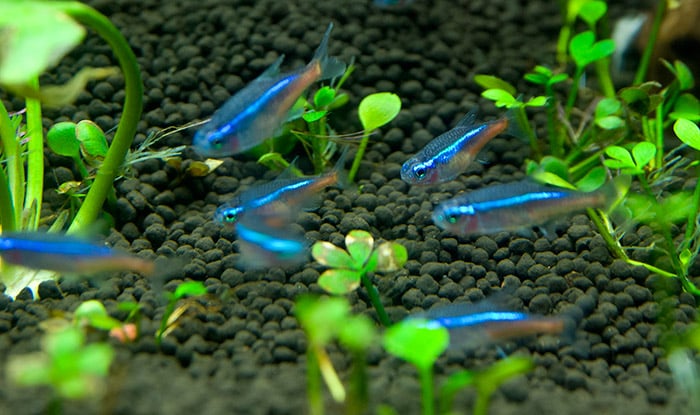
Blue Tetras are a type of Tetra that is native to the South American countries of Peru and Bolivia. These fish are known for their iridescent blue coloration.
Blue Tetras grow to be about 2 inches long and prefer to live in groups of 6 or more. They are active swimmers, thus they love ample room to play around in a tank.
Harlequin Tetras
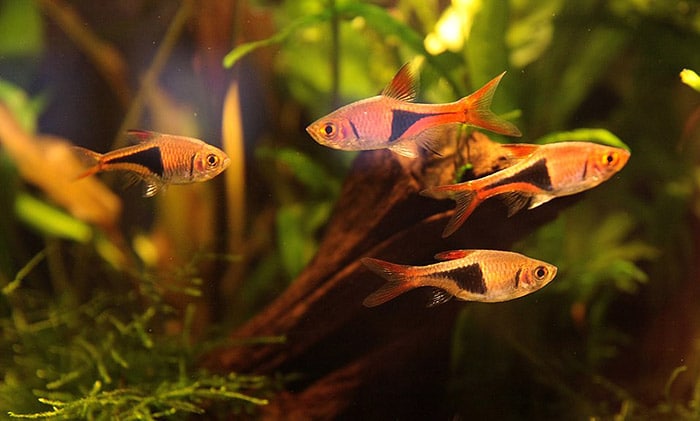
Harlequin Tetras are a type of Tetra that is native to Thailand, Singapore, and Malaysia. These fish are known for their bright red and orange coloration, which is similar to that of a harlequin clownfish.
Harlequin Tetras grow to be about 2 inches long, with a large black patch on their bodies. You can keep from 8 to 10 Harlequin Tetras together.
Tetra Fish appearance
Tetras range in size from 2.5 cm (1 inch) to 10 cm (4 inches). The majority of Tetras are less than 5 cm (2 inches) long.
Tetras are slender fish with torpedo-shaped bodies. Their coloration is highly variable, and many species have very colorful patterns on their body and fins. They are known for their bright colors and patterns, which can range from reds and oranges to blues and greens.
The typical Tetra is a small, compressed fish with a short snout. Most have an adipose fin. The caudal peduncle is slender, and the tail fin is forked. The lateral line usually has 22 to 34 scales.
One of the most distinguishing features of Tetra Fish is their eyesight. Tetra fish have extremely good eyesight, and they can see things that other fish cannot. This is due to their large eyes and their ability to see in ultraviolet light.
Tetra Fish Behavior
While most Tetras are peaceful toward other fish, there are a few species that can be territorial or aggressive toward others.
The Neon Tetra (Paracheirodon innesi) is one of the most popular species of Tetra due to its bright colors. It is a peaceful fish that does well in community tanks. However, it can be territorial towards other neon Tetras and may nip at their fins.
This is usually more common with males, as they are more territorial. If you notice your Tetras acting aggressively towards each other or other fish in the tank, you may need to separate them into different tanks.
Tetra fish are typically very active swimmers and enjoy being in groups. They will often swim near the surface of the water and may even jump out of the water occasionally. Tetras also like to play with toys and will often chase each other around the tank. They also like to have hiding places, such as plants or rocks, where they can go to feel safe.
The natural habitat of Tetra Fish varies depending on the species. Most Tetras come from tropical or subtropical regions, so they prefer warm water. However, some Tetra species come from cooler climates, so they can tolerate a wider range of temperatures.
Most Tetras prefer to live in slow-moving waters, such as rivers, streams, and lakes. Some Tetra species come from fast-moving waters, such as rapids.
Male vs Female Tetra Fish

One thing that is important to know when choosing Tetra Fish for your aquarium is the difference between male and female fish. Male and female Tetras can look very similar, but there are some key physical differences that you can look for.
Size
One of the easiest ways to tell male and female Tetras apart is by their size.
Males are generally larger than females, although there can be some overlap depending on the species. For example, in neon Tetras, males can grow up to 1.5 inches long while females only reach about 1.2 inches.
Females also tend to be fuller-bodied than males, especially when they are ready to spawn. This difference is most pronounced in certain species like black skirted Tetras, where the females can look almost twice as big as the males when they are carrying eggs.
Coloration
Male and female Tetras also differ in their coloration.
In many species, the males will be more brightly colored than the females. For example, male neon Tetras have a bright blue line running down their body, while the females are more subdued in color.
Other species show the opposite pattern, with the females being more brightly colored than the males. This is especially common in species that exhibit sexual dimorphism, where the two sexes look noticeably different from each other.
One example is the black widow Tetra, where the males are mostly black with a white spot on their belly, while the females are red with black markings on their fins.
Behavior
For Tetra, males are generally more active and aggressive than females, often chasing each other and nipping at each other’s fins. They also tend to be more territorial, staking out their little areas in the aquarium.
Females, on the other hand, are usually more peaceful and laid-back. They often form small groups with other females and don’t interact much with the males. When they do interact with males, it is usually only during spawning.
Choosing Tetras for Your Aquarium
If you want a peaceful community tank, then you’ll probably want to stick with females. If you don’t mind a little aggression and chasing, then you can go with either. And if you want bright colors, then males are usually your best bet. It comes down to personal preference and the specific species of Tetra that you’re interested in.
It is generally recommended to keep a ratio of two or three females for every male. This will help to reduce aggression and territorial behavior between the fish.
Which fish do Tetra Fish get along with
When it comes to choosing tank mates for Tetras, it is important to select fish that are of similar size and temperament? Tetras are not aggressive fish, so they should not be kept with species that are known to be bullies or nip at the fins of other fish.
Some good choices for Tetra tank mates include other peaceful freshwater fish. Some of the best fish to keep with Tetras include:
- Guppies
- Mollies
- Platies
- Swordtails
- Danios
- Barbs
- Corydoras
- Dwarf cichlids
Tetras do well with peaceful cichlids and some catfish species. Tetras also do well with Corydoras catfish, as well as some of the smaller plecos.
If you want to keep Tetras with barbs, make sure to choose a larger species, such as cherry barbs or rosy barbs, that are not likely to view the smaller Tetras as potential prey.
It’s best to avoid keeping them with larger, more aggressive fish as they may become stressed or even bullied. Avoid keeping Tetras with larger fish that could eat them, as well as aggressive fish such as cichlids and bettas.
It’s important to remember that when picking fish to put together in an aquarium, you should always try to choose fish that are similar in size. This will help prevent aggression and ensure that everyone has enough space to swim and feel comfortable.
How Big can Tetra Fish grow
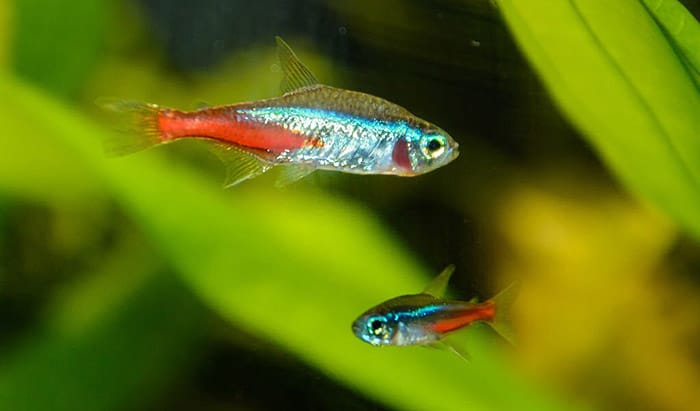
Tetra is a relatively small fish, with most species growing to be no more than 6 inches in length. However, some Tetra species can grow much larger.
The Giant Tetra, for example, can grow up to 18 inches in length. Other large Tetra species include the Red-Bellied Piranha and the Black Sharkminnow, both of which can reach lengths of 12 inches or more.
While most Tetra Fish are peaceful community fish, these larger species can be quite aggressive and should not be kept with other fish unless they are of similar size. When it comes to overall size, however, the vast majority of Tetra Fish fall somewhere in the middle, with most species growing to be between 2 and 4 inches in length.
How long do Tetra Fish live
The average lifespan of a Tetra Fish is 3-5 years, although some species have been known to live up to 10 years in captivity.
The key to keeping your Tetra Fish healthy and happy for as long as possible is to provide them with a clean and well-maintained aquarium that contains plenty of hiding places and plants. A diet of high-quality flakes or pellets will also help to ensure that your Tetra Fish live a long and healthy life.
How long can a Tetra Fish live without Food?
While most Tetra fish are not picky eaters, there may be times when they do not have access to food. In the wild, Tetra fish may go for long periods without eating due to changes in their environment or the availability of food sources.
So, how long can a Tetra fish live without food? It is difficult to say exactly as it depends on several factors, such as the species of Tetra fish, its age, and its health.
Generally speaking, however, most Tetra fish can live for several days without food. Some species may even be able to survive for weeks without eating.
If you are planning to go on vacation or will be away from home for an extended time, it is important to make sure your Tetra fish have access to food. You can do this by leaving some food in the aquarium or by setting up an automatic feeder.
It is also a good idea to check with your veterinarian before leaving your Tetra fish without food for an extended time. They can offer advice on how to best care for your Tetra fish and ensure they remain healthy while you are away.
How to Tetra Fish sleep
When a Tetra fish wants to sleep, it will slowly sink towards the bottom of the tank and then rest on its side or belly. Its fins will become still and its eyes will close. Some Tetra species will even curl up into a little ball when they sleep.
It is thought that freshwater fish like Tetras sleep more lightly than marine fish do since they have to be constantly aware of changes in their environment, such as predators or sudden water changes. However, this has not been proven definitively.
It is important to provide your Tetra fish with a dark place to sleep at night.
Use a dark-colored aquarium background or by covering the tank with a dark cloth. Tetra fish are very sensitive to light and noise, so it is important to make sure that their sleeping environment is as quiet and peaceful as possible.
If you want to watch your Tetra fish sleep, it is best to do so in a dimly lit aquarium so that they are not disturbed. Otherwise, you can simply enjoy watching them swim around and be active during the daytime hours.
If you notice that your Tetra fish are not sleeping well, it may be an indication that something is wrong with their environment. Make sure to check the water quality and temperature, as well as the lighting and filtration system.
If you cannot determine the cause of the problem, it is best to consult with a qualified aquarium specialist.
If you are concerned about your Tetra Fish not getting enough sleep, there are a few things you can do to help them.
First, make sure that their tank is set up properly. The water should be at the correct temperature, and there should be plenty of hiding places for the fish to feel safe and secure.
Second, provide them with a high-quality diet that contains all of the nutrients they need.
Finally, avoid handling or disturbing them when they are in a state of torpor.
How to choose a Tetra Fish
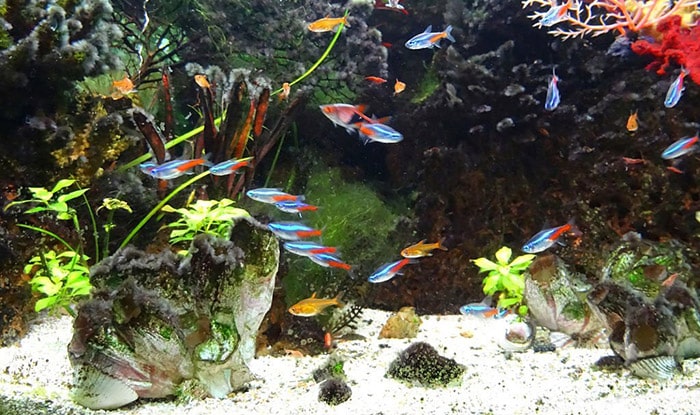
If you’re looking for a new fish to add to your aquarium, you may be considering a Tetra Fish. Here are a few things to consider when choosing a Tetra Fish:
The size of your aquarium
Tetras can range in size from around 2 inches to 6 inches, so you’ll need to make sure your tank is big enough to accommodate the fish you’re interested in. If you’re not sure how many fish your aquarium can hold. If you have a small or medium-sized aquarium (10 – 20 gallons), though, they should do just fine.
The other fish in your aquarium
As with any new fish, you’ll want to make sure the Tetra Fish you’re considering is compatible with the other fish in your tank. It’s also generally best to stick with Tetras that come from the same geographical region. This will ensure they share similar water conditions and won’t be prone to territorial aggression.
The water conditions in your aquarium.
Are you looking for a freshwater or saltwater setup? Tetras are typically found in freshwater systems, so if you’re looking for a saltwater option, you might want to consider another type of fish.
Tetra fish are fairly adaptable and can live in a variety of water conditions, but it’s still important to make sure the water in your aquarium is suitable for them. Test your water regularly and adjust accordingly if necessary.
Your level of experience
If you’re a beginner aquarist, you may want to choose a more forgiving fish like a Tetra. They are relatively easy to care for and aren’t as delicate as some other species of fish.
How much do Tetra Fish Cost
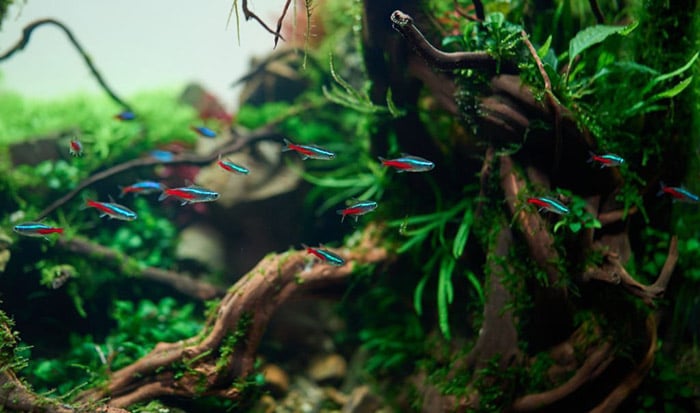
The price of a Tetra fish will vary depending on the species, size, and age of the fish.
A common Neon Tetra (one of the most popular species of Tetra) typically costs around $2-3 USD per fish. The prices can go up to $10 USD or more for rarer species like the Cardinal Tetra.
As for size, larger Tetra fish will cost more than smaller ones. And finally, younger fish are usually cheaper than adults since they have not yet reached their full size or coloration.
So, how much does Tetra fish cost in total? It depends on the factors mentioned above. A small group of common Neon Tetras may only cost you around $10-20 USD, while a larger group of rarer Tetras can set you back $100 USD or more. it all comes down to what you’re looking for in a pet fish!
How many Tetra Fish in a tank
When stocking a tank with Tetras, it is important to consider the size of the fish and the size of the tank. A good rule of thumb is to allow 2-3 gallons of water per 1 inch of adult fish.
So, for a 20-gallon tank, you could keep 4-6 adult Tetras. If you want to keep more than 6 Tetras, you will need to upgrade to a larger tank.
Tetras are social creatures and do best in groups. A minimum of 5 Tetras is recommended, but more is better.
Can Tetra Fish live without a pump?
While Tetra Fish are generally hardy creatures that can adapt to a wide range of water conditions, they do need some basic level of care to thrive. One of the most important things you can do for your Tetra Fish is to provide them with a good quality aquarium pump.
Aquarium pumps help to keep the water in your tank clean and oxygenated, which is essential for the health of your fish.
Without a pump, Tetra fish may become stressed and more susceptible to disease. In addition, an aquarium pump will help to create a current in your tank that simulates their natural environment and helps to keep them active and healthy.
So, while Tetra fish can technically survive without an aquarium pump, it is not recommended and will ultimately lead to a shorter, less healthy life for your fish.
Can Tetra Fish live without a heater?
While Tetra fish can technically survive without a heater, their quality of life will be significantly lower. Tetra fish are tropical fish and prefer waters that are between 75-80 degrees Fahrenheit.
Without a heater, the water temperature will fluctuate and may drop too low for the Tetra fish to be comfortable. In addition, Tetra fish are more susceptible to disease when kept in cooler waters.
For these reasons, it is best to provide a heater for your Tetra fish tank.
Conclusion
Tetras are a varied and popular group of freshwater fish that make great additions to many home aquariums. Though they vary in size, shape, and color, most Tetras are small, peaceful fish that get along well with other fish of similar size and temperament.
Tetras are easy to care for and can be a great choice for beginner aquarists. With proper care, Tetras can live for 5-10 years in the home aquarium.
Remember, different Tetras can have slightly different care requirements! But with a little planning, you can have a beautiful and peaceful aquarium full of these lovely little fish. Thanks for reading!




